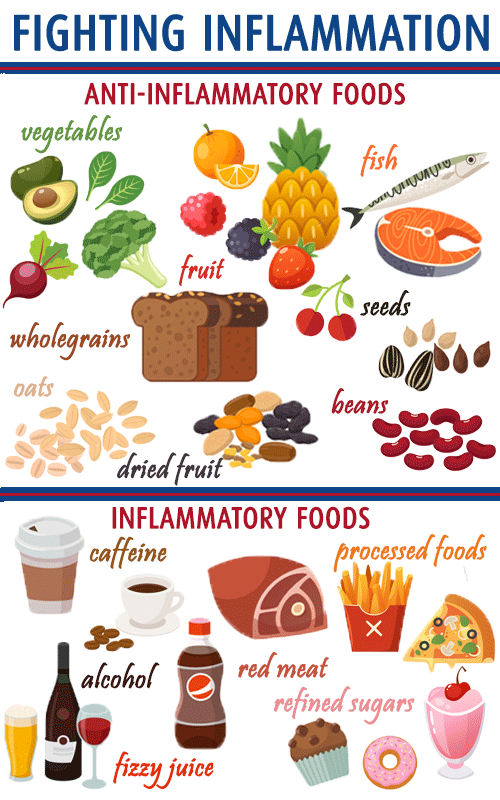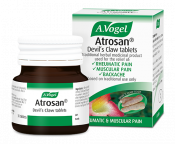What is inflammation and why is it bad?
Inflammation usually occurs after an infection or injury. Its aim is to repair body tissues and remove damaging agents. In doing so, inflammation can lead to red skin, swelling, pain and skin that is hot to the touch.
Although this is a normal and necessary process, inflammation can occasionally get out of control leading to chronic tissue damage. In the long term, it can also contribute to osteoarthritis, autoimmune illness and chronic infections.
Non-steroidal anti-inflammatory drugs (NSAIDs) are commonly used to treat inflammation (including arthritis and back pain) but these may come with side effects, such as indigestion and drowsiness; so, many people seek an alternative.
Diet can play a useful part in managing inflammation and there are a few foods in particular to focus on. These include:
- Vegetables
- Fish
- Oats
- Dried fruit
- Seeds
- Beans
- Fresh fruit
- Wholegrains
Let's look in a little more detail at why these foods are helpful for anyone experiencing inflammation, and find out how much you should consume on a daily basis.
1. Vegetables
Research shows that plant-based foods may help to modulate inflammatory processes.1
Spinach and other leafy green vegetables are particularly noted for their anti-inflammatory action, as well as their abundance of nutrients. Spinach itself is a good source of iron, potassium and magnesium. Low levels of magnesium have been linked to high levels of inflammation2 so this is one to keep topped up. Spinach is particularly helpful as it is also rich in calcium which helps us to absorb magnesium.
It is difficult for the body to store magnesium so we need to keep levels topped up through our diet.
Other veggies that are known to offer anti-inflammatory benefits include beetroot, Bok Choy, kale, broccoli, avocado and more!
How much?
The World Health Organisation recommends eating 5 portions of fruit and vegetables every day3 to get the protective benefits of them. However, if you can squeeze in a few extra portions, this could bring additional health benefits. A general rule is that one portion should fit in the palm of your hand.
Good sources:
Soups and smoothies are a good way to get a couple of portions of vegetables at the one time. Take your pick from the likes of our Apple & Spinach Smoothie or Broccoli & Potato Soup.
My Top Tip:

This drink is made from organically-pressed vegetables and is not from concentrate.
"Excellent. Can't fault it in any way."

2. Fish
Oily fish, including salmon, mackerel and herring, are good sources of omega-3 fatty acids. Studies show that the omega-3 fatty acids found in fish and fish oil supplements (as well as nuts and seeds for any vegetarians) may help reduce pain and inflammation.4
This may be linked to resolvins that are made from the omega-3 fatty acids in our diet. Resolvins can control inflammation by stopping the movement of inflammatory chemicals to areas of inflammation. They are also able to turn on other inflammatory cells to stop them from perpetuating inflammatory processes.5
How much?
It is recommended we eat at least two portions of fish a week, including one meal with an oily fish such as salmon.6
Good sources:
Vegetarian sources of omega-3 fatty acids include chia seeds, walnuts and kidney beans which should be consumed regularly.
Swap meat for fish at least twice a week. Fish can be incorporated into some family favourites like curry, stir fry and pies - look at some of our easy fish recipes for inspiration!
3. Oats
Oats are a good source of antioxidants which are helpful when inflammation is present.
Inflammation can raise levels of a molecule called reactive oxygen species (ROS). This is problematic as these molecules can damage cells and tissues and, in excess, they can advance the development of inflammatory diseases.7 This is a state known as oxidative stress that we want to avoid, as it has been linked to various conditions from arthritis to hypertension.
Antioxidants are helpful here as they can protect cells from damage caused by ROS.
How much?
It is generally recommended we should consume one portion of oats a day. This should equate to one cup at a time.
Good sources:
There are lots of tasty ways to consume oats, from the traditional porridge, to overnight oats, breakfast bars and muesli.
4. Dried fruit
In studies, dried fruit has been shown to reduce levels of an inflammatory marker called cytokines, when combined with other healthy lifestyle habits like exercise.8
Dried fruit can also be a good source of antioxidants which can be helpful in combatting inflammation.
How much?
No more than a handful of dried fruit should be consumed per day. It's a great idea to vary the types of dried fruit you're having, to get a wide range of vitamins and minerals from them.
Good sources:
Raisins, dates, prunes, figs and apricots are just a few examples of dried fruits. When shopping for these, be sure to check the product labels first as some varieties, such as dried cranberries and blueberries, will nearly always have had refined sugar added to them.
5. Seeds
Certain seeds can be a good source of omega-3 fatty acids which we know to be anti-inflammatory. This makes them a good alternative for vegans and vegetarians who are unable to gain the benefits of omega-3 from fish.
How much?
A handful of seeds per day is sufficient.
Good sources:
Linseeds, chia seeds and hemp seeds are but a few options. For something a little bit different, try our Cinnamon and Chia Seed Energy Balls to get your daily intake up!
Alternatively, try roasting some seeds with a little turmeric, soy sauce and Herbamare. As an added bonus, the active compound in turmeric, curcumin, has anti-inflammatory properties.
6. Beans
Levels of C-reactive protein rise in response to inflammation. Including beans in the diet can be of benefit as beans are able to lower C-reactive protein levels due to their antioxidants and nutrient content. Beans are, for example, a good source of magnesium, iron, zinc and potassium.
How much?
We should consume one portion of beans per day, with 80g making up one serving.
Good sources:
There are lots of different varieties of beans, including baked, kidney, cannellini, pinto and borlotti beans. These can make a great substitute for meat in dishes like chilli and bolognaise.

7. Fresh fruit
Strawberries, blueberries, cherries and oranges are just a few examples of some tasty anti-inflammatory fruits. These contain nutrients like vitamin C which are high in antioxidants9, such as anthocyanins, as well as polyphenol compounds. Both of these provide the fruit with some of its anti-inflammatory effects.10
In studies, berries have also been shown to reduce the overall levels of inflammatory markers in the body.11
Another notable component of fruit is quercetin, a flavonoid that research has shown brings anti-inflammatory benefits after exercise.12 Quercetin is present in blueberries, pineapples, oranges and more.
How much?
We need to consume at least 5 portions of fruit and vegetables a day, of which fruit should only be one or two portions.
Good sources:
Mixing up a fruit salad is a great way to get a couple of portions of fruit at one time.
Fresh fruit juice is another source but remember, only one glass of fruit juice can be counted towards your 5 a day.
8. Wholegrain bread
White varieties of bread and pasta are highly processed and can actually contribute to inflammation. Wholegrains are not only a much healthier alternative in that they offer more nutrients, but they have also been found to reduce inflammation.13
How much?
Current guidelines recommend eating at least 3 servings of wholegrains a day.
Good sources:
Wholegrains include barley, brown rice, buckwheat, bulgar and oatmeal.
References
2 https://www.ncbi.nlm.nih.gov/pmc/articles/PMC5783146/
4 https://www.ncbi.nlm.nih.gov/pubmed/22254027
5 https://rupress.org/jem/article/201/5/713/40223/Stereochemical-assignment-antiinflammatory
6 https://www.nhs.uk/live-well/eat-well/fish-and-shellfish-nutrition/
10 https://www.ncbi.nlm.nih.gov/pubmed/24512603
11 https://www.ncbi.nlm.nih.gov/pubmed/21242652
12 https://www.ncbi.nlm.nih.gov/pubmed/22111516
13 https://www.ncbi.nlm.nih.gov/pmc/articles/PMC6221555/








